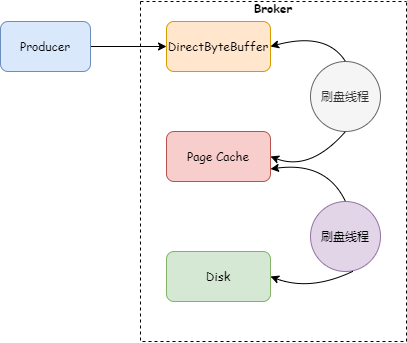
大家好,我是君哥。
在使用 RocketMQ 的过程中,有时候我们会看到下面的日志:
[TIMEOUT_CLEAN_QUEUE]broker busy, start flow control for a while, period in queue: 206ms, size of queue: 5
这是因为 RocketMQ 触发了流量控制。今天我们来聊一聊哪些场景下 RocketMQ 会触发流量控制。

如上图,生产者把消息写入 Broker,Consumer 从 Broker 拉取消息。Broker 是 RocketMQ 的核心 ,触发流量控制主要就是为了防止 Broker 压力过大而宕机。
一、 Broker 流控
1、 broker busy
RockerMQ 默认采用异步刷盘策略,Producer 把消息发送到 Broker 后,Broker 会先把消息写入 Page Cache,刷盘线程定时地把数据从 Page Cache 刷到磁盘上,如下图:


那 broker busy 是怎么导致的呢?
Broker 默认是开启快速失败的,处理逻辑类是 BrokerFastFailure,这个类中有一个定时任务用来清理过期的请求,每 10 ms 执行一次,代码如下:
public void start() {
this.scheduledExecutorService.scheduleAtFixedRate(new Runnable() {
@Override
public void run() {
if (brokerController.getBrokerConfig().isBrokerFastFailureEnable()) {
cleanExpiredRequest();
}
}
}, 1000, 10, TimeUnit.MILLISECONDS);
}
(1)Page Cache 繁忙
清理过期请求之前首先会判断 Page Cache 是否繁忙,如果繁忙,就会给 Producer 返回一个系统繁忙的状态码(code=2,remark="[PCBUSY_CLEAN_QUEUE]broker busy, start flow control for a while, period in queue: %sms, size of queue: %d"),也就是本文开头的异常日志。那怎么判断 Page Cache 繁忙呢?Broker 收到一条消息后会追加到 Page Cache 或者内存映射文件,这个过程首先获取一个 CommitLog 写入锁,如果持有锁的时间大于 osPageCacheBusyTimeOutMills(默认 1s,可以配置),就认为 Page Cache 繁忙。具体代码见 DefaultMessageStore 类 isOSPageCacheBusy 方法。
(2)清理过期请求
清理过期请求时,如果请求线程的创建时间到当前系统时间间隔大于 waitTimeMillsInSendQueue(默认 200ms,可以配置)就会清理这个请求,然后给 Producer 返回一个系统繁忙的状态码(code=2,remark="[TIMEOUT_CLEAN_QUEUE]broker busy, start flow control for a while, period in queue: %sms, size of queue: %d")。
system busy
这个异常在 NettyRemotingAbstract#processRequestCommand 方法。
拒绝请求
如果 NettyRequestProcessor 拒绝了请求,就会给 Producer 返回一个系统繁忙的状态码(code=2,remark="[REJECTREQUEST]system busy, start flow control for a while")。那什么情况下请求会被拒绝呢?看下面这段代码:
//SendMessageProcessor类
public boolean rejectRequest() {
return this.brokerController.getMessageStore().isOSPageCacheBusy() ||
this.brokerController.getMessageStore().isTransientStorePoolDeficient();
}
从代码中可以看到,请求被拒绝的情况有两种可能,一个是 Page Cache 繁忙,另一个是 TransientStorePoolDeficient。
跟踪 isTransientStorePoolDeficient 方法,发现判断依据是在开启 transientStorePoolEnable 配置的情况下,是否还有可用的 ByteBuffer。
注意:在开启 transientStorePoolEnable 的情况下,写入消息时会先写入堆外内存(DirectByteBuffer),然后刷入 Page Cache,最后刷入磁盘。而读取消息是从 Page Cache,这样可以实现读写分离,避免读写都在 Page Cache 带来的问题。如下图:

线程池拒绝
Broker 收到请求后,会把处理逻辑封装成到 Runnable 中,由线程池来提交执行,如果线程池满了就会拒绝请求(这里线程池中队列的大小默认是 10000,可以通过参数 sendThreadPoolQueueCapacity 进行配置),线程池拒绝后会抛出异常 RejectedExecutionException,程序捕获到异常后,会判断是不是单向请求(OnewayRPC),如果不是,就会给 Producer 返回一个系统繁忙的状态码(code=2,remark="[OVERLOAD]system busy, start flow control for a while")。
判断 OnewayRPC 的代码如下,flag = 2 或者 3 时是单向请求:
public boolean isOnewayRPC() {
int bits = 1 << RPC_ONEWAY;
return (this.flag & bits) == bits;
}
(3) 消息重试
Broker 发生流量控制的情况下,返回给 Producer 系统繁忙的状态码(code=2),Producer 收到这个状态码是不会进行重试的。下面是会进行重试的响应码:
//DefaultMQProducer类
private final Set<Integer> retryResponseCodes = new CopyOnWriteArraySet<Integer>(Arrays.asList(
ResponseCode.TOPIC_NOT_EXIST,
ResponseCode.SERVICE_NOT_AVAILABLE,
ResponseCode.SYSTEM_ERROR,
ResponseCode.NO_PERMISSION,
ResponseCode.NO_BUYER_ID,
ResponseCode.NOT_IN_CURRENT_UNIT
));
二、 Consumer 流控
DefaultMQPushConsumerImpl 类中有 Consumer 流控的逻辑 。
1、 缓存消息数量超过阈值
ProcessQueue 保存的消息数量超过阈值(默认 1000,可以配置),源码如下:
if (cachedMessageCount > this.defaultMQPushConsumer.getPullThresholdForQueue()) {
this.executePullRequestLater(pullRequest, PULL_TIME_DELAY_MILLS_WHEN_FLOW_CONTROL);
if ((queueFlowControlTimes++ % 1000) == 0) {
log.warn(
"the cached message count exceeds the threshold {}, so do flow control, minOffset={}, maxOffset={}, count={}, size={} MiB, pullRequest={}, flowControlTimes={}",
this.defaultMQPushConsumer.getPullThresholdForQueue(), processQueue.getMsgTreeMap().firstKey(), processQueue.getMsgTreeMap().lastKey(), cachedMessageCount, cachedMessageSizeInMiB, pullRequest, queueFlowControlTimes);
}
return;
}
2、缓存消息大小超过阈值
ProcessQueue 保存的消息大小超过阈值(默认 100M,可以配置),源码如下:
if (cachedMessageSizeInMiB > this.defaultMQPushConsumer.getPullThresholdSizeForQueue()) {
this.executePullRequestLater(pullRequest, PULL_TIME_DELAY_MILLS_WHEN_FLOW_CONTROL);
if ((queueFlowControlTimes++ % 1000) == 0) {
log.warn(
"the cached message size exceeds the threshold {} MiB, so do flow control, minOffset={}, maxOffset={}, count={}, size={} MiB, pullRequest={}, flowControlTimes={}",
this.defaultMQPushConsumer.getPullThresholdSizeForQueue(), processQueue.getMsgTreeMap().firstKey(), processQueue.getMsgTreeMap().lastKey(), cachedMessageCount, cachedMessageSizeInMiB, pullRequest, queueFlowControlTimes);
}
return;
}
3、 缓存消息跨度超过阈值
对于非顺序消费的场景,ProcessQueue 中保存的最后一条和第一条消息偏移量之差超过阈值(默认 2000,可以配置)。源代码如下:
if (!this.consumeOrderly) {
if (processQueue.getMaxSpan() > this.defaultMQPushConsumer.getConsumeConcurrentlyMaxSpan()) {
this.executePullRequestLater(pullRequest, PULL_TIME_DELAY_MILLS_WHEN_FLOW_CONTROL);
if ((queueMaxSpanFlowControlTimes++ % 1000) == 0) {
log.warn(
"the queue's messages, span too long, so do flow control, minOffset={}, maxOffset={}, maxSpan={}, pullRequest={}, flowControlTimes={}",
processQueue.getMsgTreeMap().firstKey(), processQueue.getMsgTreeMap().lastKey(), processQueue.getMaxSpan(),
pullRequest, queueMaxSpanFlowControlTimes);
}
return;
}
}
4、获取锁失败
对于顺序消费的情况,ProcessQueue 加锁失败,也会延迟拉取,这个延迟时间默认是 3s,可以配置。
三、总结
本文介绍了 RocketMQ 发生流量控制的 8 个场景,其中 Broker 4 个场景,Consumer 4 个场景。Broker 的流量控制,本质是对 Producer 的流量控制,最好的解决方法就是给 Broker 扩容,增加 Broker 写入能力。而对于 Consumer 端的流量控制,需要解决 Consumer 端消费慢的问题,比如有第三方接口响应慢或者有慢 SQL。
在使用的时候,根据打印的日志可以分析具体是哪种情况的流量控制,并采用相应的措施。



































